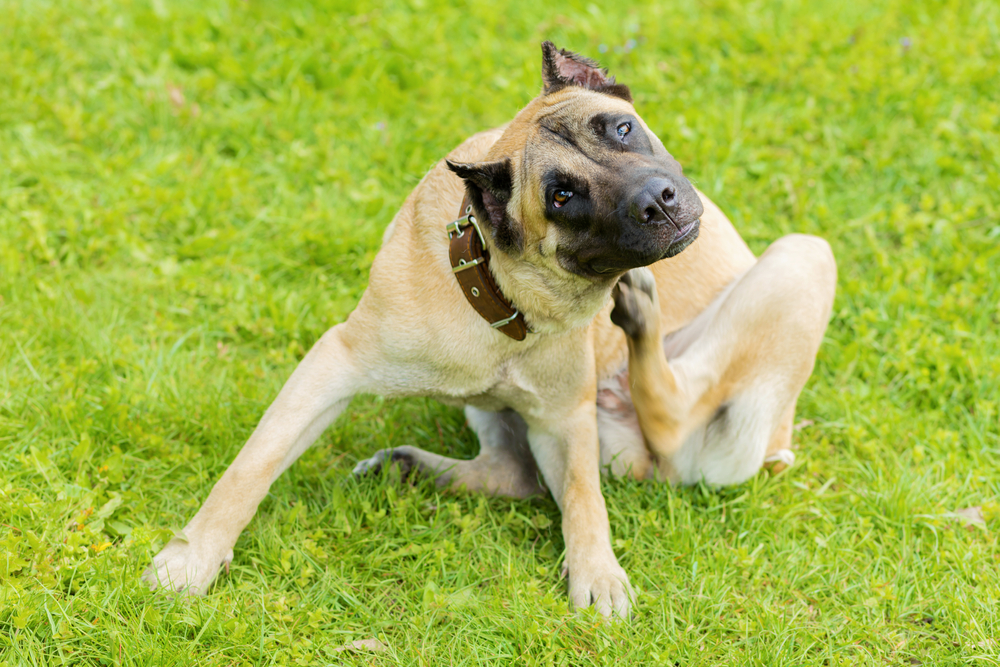8 Vet-Verified Signs of an Allergic Reaction in Dogs to Be Aware Of

Allergies are, unfortunately, fairly common in dogs. Dogs can be allergic to a variety of things, including dust mites, pollen, mold, insect bites and stings, and various kinds of food. The signs of allergies can range from mild to severe and potentially life-threatening, so it’s important to be familiar with the possible signs and know what to do if you think your dog may be suffering from an allergy. We’ll go over a few common signs of an allergic reaction in dogs and what you can do to help your dog if you notice them.


The 8 Signs of an Allergic Reaction in Dogs
1. Hives
Hives (also known as urticaria) are small red raised bumps or larger welts that appear on a dog’s skin and are caused by an allergic reaction. Hives can appear anywhere on the body and are usually itchy. Although hives are relatively uncommon in dogs, they are most commonly caused by a reaction to insect bites and stings, shampoos, and medications.
Typically the wheals appear quickly and can often disappear just as fast. However, there is a risk that the allergic reaction can worsen leading to dangerous swelling or anaphylaxis, so it’s always best to seek veterinary advice if your dog has developed hives.
2. Itchiness
Skin itchiness is the most common sign of allergies in dogs. Therefore, it’s important to pay attention to your dog and look for excessive scratching, licking and chewing. It’s also helpful to examine their skin periodically to look for redness and rashes. Environmental allergies (such as pollen and house dust mites), food allergies and flea allergic dermatitis can all cause skin irritation and itchiness.


3. Hair Loss
Because allergies often affect skin health, you may notice hair loss and even bald patches on your dog. If your dog is itchy they may damage the skin or break and pull out hairs when they are scratching and chewing at themselves.
4. Face Swelling
Sometimes, allergies can cause certain parts of your dog’s body to swell. Swelling is most commonly seen around the face, and you may notice your dog’s muzzle, eyelids, ears, and mouth become red and swollen.
While face swelling may sound scary, there are varying degrees of swelling that range from mild to severe. Mild cases of facial swelling may resolve with minimal treatment but more severe swelling can become life-threatening and will require immediate medical attention. Always contact your vet straight away if your dog has a swollen face.
5. Coughing and Sneezing
Inhaled allergens can also affect a dog’s respiratory system and cause irritation and inflammation.
Similar to humans, dogs can sometimes start to sneeze and have a runny nose when they have allergies.They may also wheeze or cough. If your dog is showing any of these signs then you should get them checked out by your vet and they can prescribe appropriate medication to help them manage their allergy symptoms. Many other health conditions can cause similar signs and these need to be ruled out.


6. Vomiting and Diarrhea
Most dogs will get an upset stomach if they eat something that they’re allergic to, and they can experience vomiting, diarrhea, gassiness, and tummy pain. Common food allergens for dogs include chicken, beef, and dairy.
When dogs have food allergies, they can show signs other than an upset stomach. They may also experience itchy skin and recurrent skin infections.
7. Chronic Ear Infections
Dogs with allergies are unfortunately also prone to getting ear infections. Ear infections can be secondary to food allergies and environmental allergies.
If your dog has signs of an ear infection, such as increased discharge and irritation, it’s always best to take them to your vet for a proper examination. Ear infections can range from mild to serious cases that can even rupture your dog’s eardrum.
8. Anaphylaxis
Anaphylaxis is an immediate, severe and sometimes life-threatening allergic reaction. Signs can include breathing difficulties, swelling of the face and throat, severe vomiting or diarrhea, tremors, collapse and seizures.
Signs come on very quickly and severely so rapid veterinary attention is vital, especially if your dog is showing signs of shock or difficulty breathing.




How Can I Know if My Dog Has Allergies?
As there are so many different allergens and types of allergic reactions it’s important to consult with your veterinarian for a proper diagnosis and treatment plan.
Sometimes, it’s easy to identify allergens. For example, bug bites and stings are sometimes obvious culprits because they usually cause swelling near the area of the bite or sting. Flea allergic dermatitis is also usually fairly easy to diagnose. However, reactions to environmental allergens, like pollen, can be more difficult to detect. Diagnosis usually starts with ruling out other skin conditions that cause similar signs such as parasites and infections.
If your vet is suspicious of food allergies they may ask you to put your dog onto an elimination diet which involves feeding them a new food and source of protein that they have not had before, or a hydrolyzed diet where the proteins have been broken down so small they don’t react with the immune system.
Allergy skin tests and serology (blood) tests are available when other conditions have been ruled out to pinpoint the environmental allergens that your dog is reacting to.


Conclusion
Dogs can be allergic to a wide variety of things, and they can develop allergies at any point of their lives. Allergies can manifest in various ways from mild signs to severe life-threatening anaphylaxis. Understanding the common signs of an allergic reaction and knowing when to seek veterinary care helps ensure your dog remains healthy and comfortable.
Featured Image Credit: ElenaYakimova, Shutterstock



